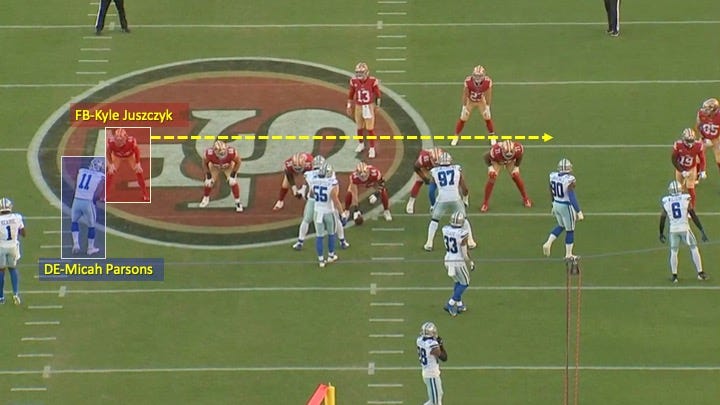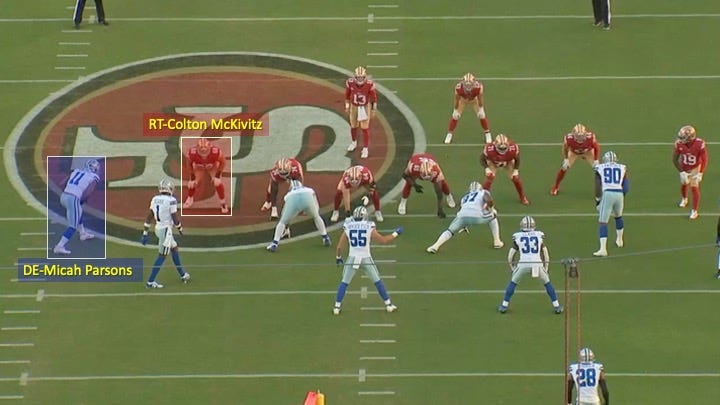Neutralizing Great Pass Rushers
Not every team has a game-wrecking pass rusher. There are only so many Myles Garretts, Micah Parsons, T.J. Watts, and Nick Bosas. So when offenses face these types of players, they can’t just treat them like any other pass rusher. Instead, they have to center their game plans around neutralizing them, first and foremost, in order to let the offense operate at a high level.
This is always easier said than done, but there have been several examples of great approaches in recent years that I could point to. In this breakdown, I’ll focus on how two of the best offensive minds in the game, Andy Reid and Kyle Shanahan, have handled some of the NFL’s top pass rushers.
Receive breakdowns like this directly in your inbox by subscribing here:
In Week 5 of the 2023 season, the 49ers hosted the Cowboys on Sunday Night Football. In what was supposed to be a showdown between two of the NFC’s best teams (and the eventual #1 and #2 seeds), San Francisco won in a blowout, 42-10. The success they had on offense that night was largely spearheaded by their ability to eliminate Micah Parsons from the game. He was held without a sack or an impact play.
So how did Shanahan do it? With an assortment of tactics of course. He used everything from chips to motion to pulling action in Parsons’ direction. All were designed to force hesitation, keeping him from pinning his ears back and attacking the quarterback. Not to mention, the O-line slid in his direction on almost every straight dropback.
Early in the game, Shanahan set the tone by not allowing Parsons to trust what he was seeing if he appeared to have a 1-on-1 off the edge.
Just take a look at this play from the 49ers’ first drive. Fullback Kyle Juszczyk initially aligned over Parsons but then motioned across the formation:
Parsons now appeared to have a 1-on-1 against right tackle Colton McKivitz:
At the snap, however, tight end George Kittle would motion across the formation in Parsons’ direction and Juszczyk would pull behind him:
The play-fake and motion/pulling action towards Parsons forced him to hesitate. The two bodies in front of him secured the edge. The result was a clean pocket for Purdy, and the seeds of uncertainty were planted in Parsons’ head:
Here was another example from San Francisco’s first drive. This time, Parsons was on the right side of the defensive front. Focus on the motion man. That’s fullback Kyle Juszczyk again:
What do you think was going through Parsons’ head as that play transpired? “Ooh, I’ve got a 1-on-1. Oh wait, here comes Juszczyk motioning towards me. Now there he goes away from me into an I-formation. Nice, I’ve got a 1-on-1 again. Unless they don’t throw it, because this kind of looks like it might be a run now. Nope, it’s a pass. I’ve got a 1-on-1 again. But wait, there’s that little gnat Juszczyk helping out on me. WTF just happened.”
Here are a couple other examples. This first play ended in an incompletion, but it’s worth showing because it still had an impact on Parsons.
The 49ers ran play-action to Parsons’ side. Left tackle Trent Williams went out to get him and take away the edge. Juszczyk provided help inside this time:
That block seemed to stun Parsons momentarily.
Here’s one more example. Your standard chip, this time by tight end George Kittle before he went out into his route:
As fun as those different tactics for solidifying protection are, it’s hard to go through an entire game only using your eligible receivers to help out on a dominant pass rusher. Eventually, you have to be able to protect with just 5.
The 49ers’ plan in these situations was to slide in Parsons’ direction on almost every straight drop-back that used a 5-man protection. That allowed an extra blocker to provide late help on Parsons.
Just watch here. Notice Parsons on the right. The 49ers would use a 4-man slide towards him:








